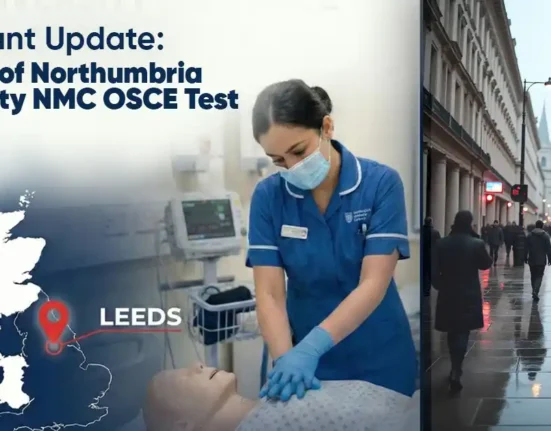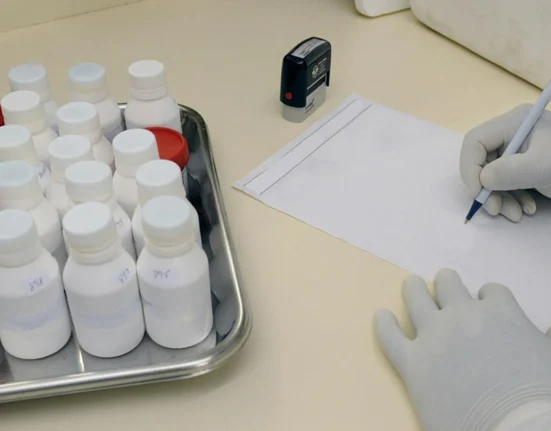Pressure ulcers are a significant concern in nursing care, particularly for patients with limited mobility. As part of the NMC OSCE (Objective Structured Clinical Examination), the Pressure Area Assessment is a fundamental station that tests your ability to identify risk factors, perform a structured assessment, and assign an appropriate score based on the patient’s condition.
Whether you are an internationally educated nurse preparing for UK registration or a return-to-practice nurse, this guide will break down everything you need to succeed at this NMC OSCE station.
NMC OSCE Pressure Area Assessment Station
In the NMC OSCE, the Pressure Area Assessment is a silent station. This means no patient (actor) or examiner is interacting with you. Instead, you are presented with a patient scenario and documentation chart. You will get 8 minutes to complete the station.
Your Task:
- Interpret the given scenario carefully
- Understand each element of pressure area assessment
- Document the score accurately
- Document a minimum of 8 areas of pressure risk and a minimum of 7 signs of pressure ulcer development

Step-by-Step Guide to the NMC OSCE Pressure Area Assessment
1. Read the Patient Scenario Carefully
You will be given each element information in the scenario, such as:
- Sensory perception
- Moisture
- Activity
- Mobility
- Nutrition
- Friction and shear
2. Understand each element accurately
- Sensory perception- It indicates the ability to respond meaningfully to pressure-related discomfort. We score on the basis of the patient’s ability to respond.
- Moisture- Degree to which skin is exposed to moisture. Here, consider urine incontinence while identifying the score.
- Activity- Degree of physical activity. For identifying score, check the scenario and identify whether the patient is bedridden or able to sit, or can occasionally walk.
- Mobility- Ability to change and control body position.
- Nutrition- Usual food intake pattern. Here, checks the quantity of food the patient consumes and if taking any supplements or not
- Friction and shear- Assistance in moving
Identify each element score as per the information given in the scenario. Match details with the chart and score accurately.

Download Marking Criteria
Enter the status of your OSCE preparation to get customized OSCE Updates and Tips
3. Use the provided Braden chart
This Braden scoring tool includes several risk categories:
| Elements | Examples |
| Sensory perception | Completely limited, very limited, slightly limited, no impairment |
| Moisture | Constantly Moist, very moist, occasionally moist, rarely moist |
| Activity | Bedfast, chairfast, walks occasionally, walks frequently |
| Mobility | Immobile, Very limited, slightly limited, no limitation |
| Nutrition | Very poor, probably inadequate, adequate, Excellent |
| Friction and shear | Problem, Potential problem, No problem |
4. Document Your Score Clearly
You need to record:
- Each element scored correctly
- Total score of the scenario
- Minimum of 8 areas of pressure risk and a minimum of 7 signs of pressure ulcer development
- The most vulnerable areas of pressure risk- Heels, sacrum, buttocks, elbows, temporal region of the skull, shoulders, hips, back of head, toes, ears, and spine.
- The most vulnerable sign of pressure ulcer development- Persistent erythema, non-blanching hyperaemia, blisters, discolouration, localised heat, localised oedema, localised indurations, purplish/bluish localised areas, localised coolness.
Tips for Success
- Follow a systematic approach for NMC OSCE Pressure area assessment
- Understand the Braden tool thoroughly
- Practise different scenarios and score elements
- Stay within your station time limit
- Neatly document all the details and score
Mastering the Pressure Area Assessment silent station is not just about passing your NMC OSCE; it is about protecting vulnerable patients from harm. The Pressure Area Assessment station is silent, but your documentation speaks volumes. A systematic approach will help you with the preparation of the NMC OSCE
With preparation, practice, and precision, you’ll be ready to approach this station confidently and achieve it in the NMC OSCE.
NMC OSCE for Nurses: Everything You Need to Know in 2025. Click Here
For any NMC OSCE OSCE-related queries and Training, Chat with us!










